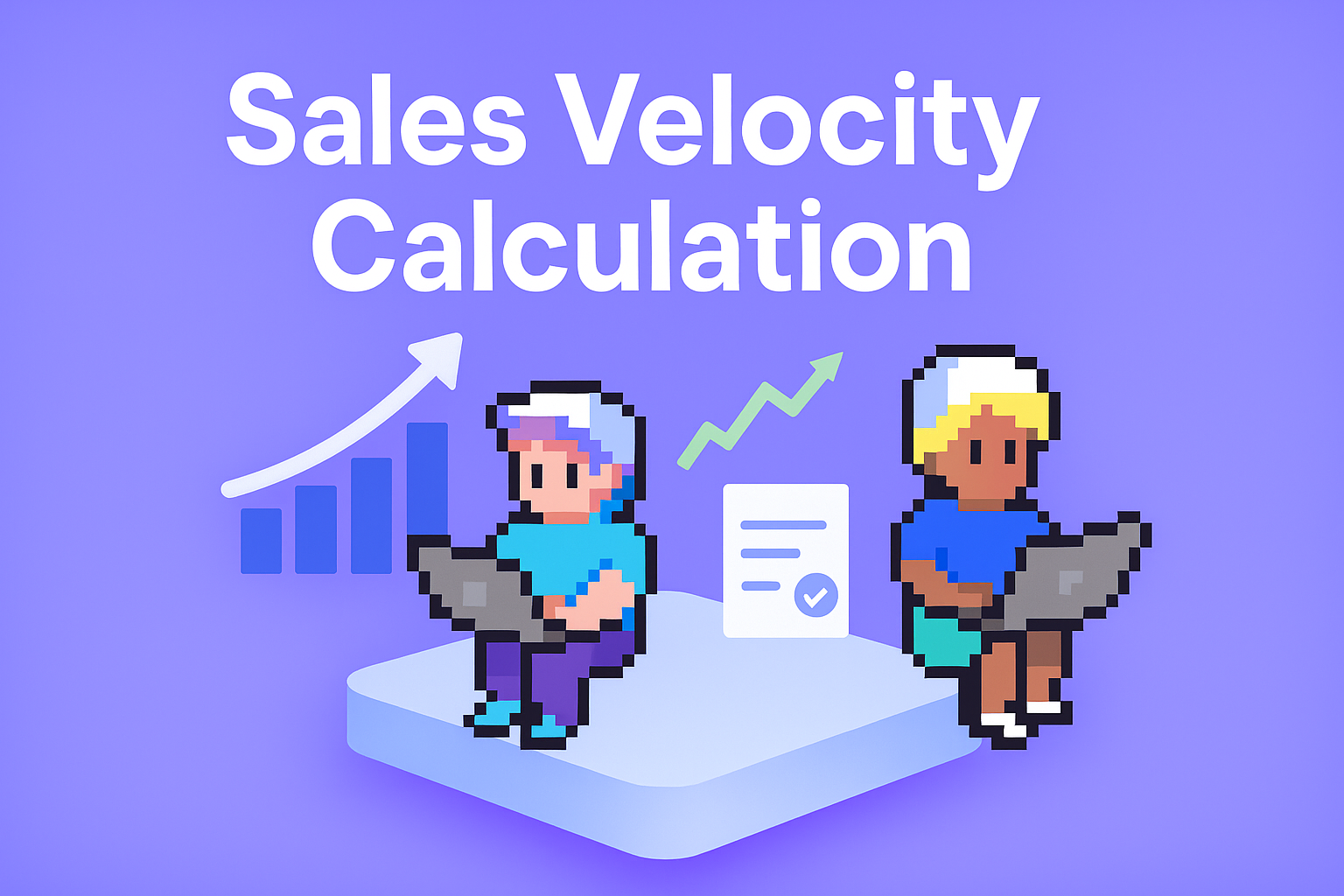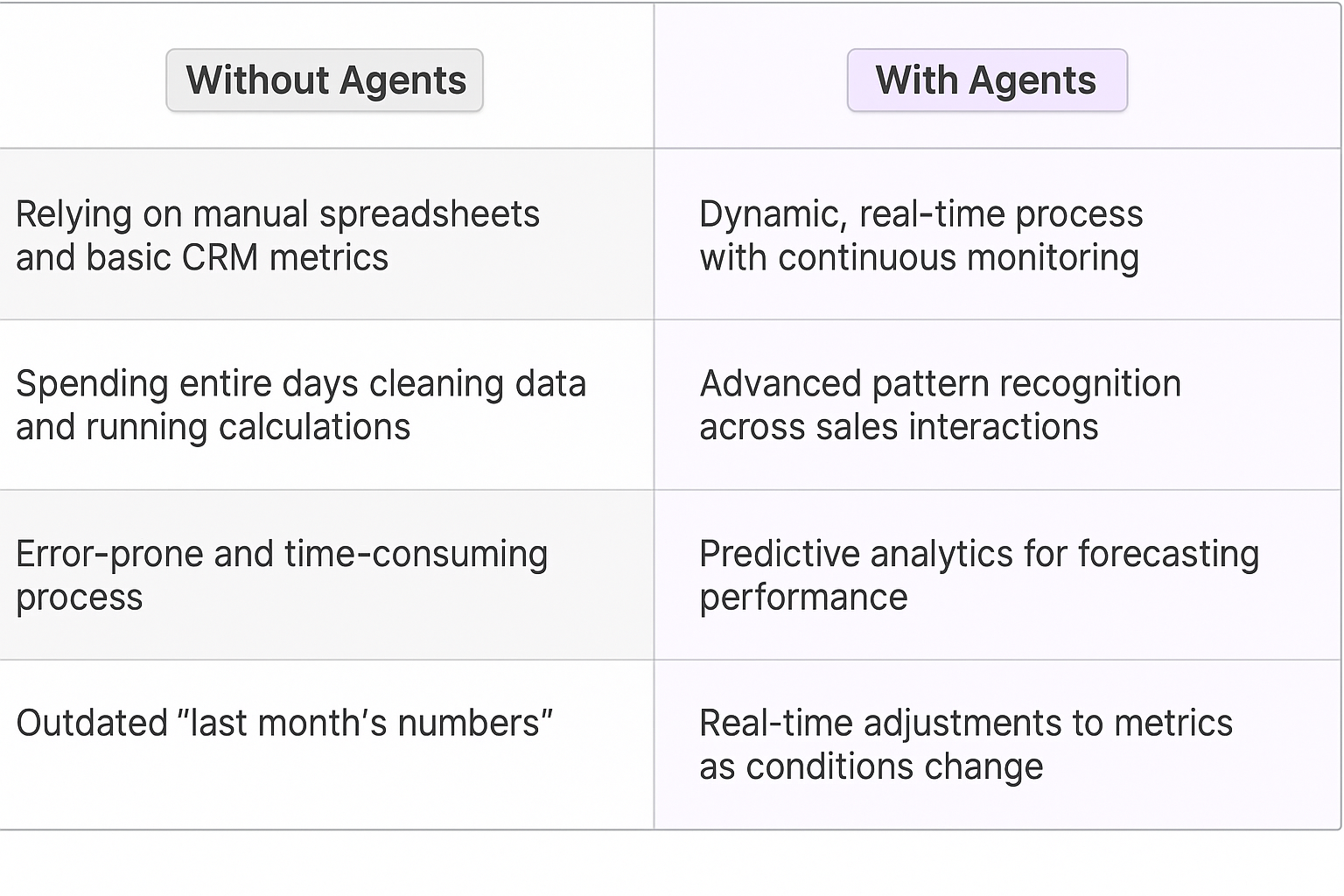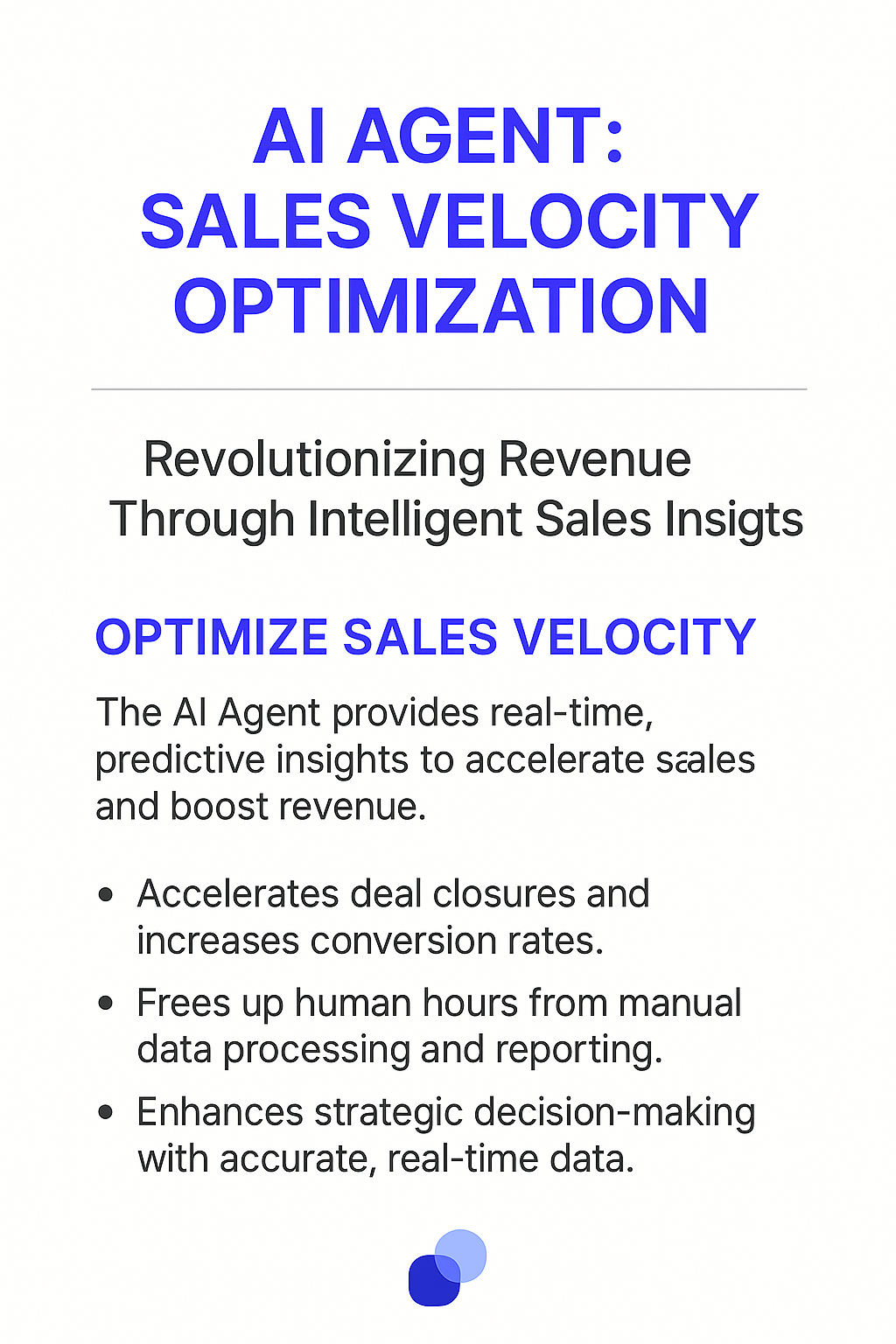Sales Velocity Calculation AI Agents
Understanding Sales Velocity and AI-Powered Analysis
What is Sales Velocity Calculation?
Sales velocity calculation measures how quickly deals move through your pipeline and generate revenue. Traditional methods relied on manual spreadsheets and basic CRM metrics, but AI agents transform this into a dynamic, real-time process. The technology analyzes multiple variables including deal size, conversion rates, sales cycle length, and pipeline volume to provide a comprehensive view of sales performance.
Key Features of Sales Velocity Calculation
- Continuous monitoring of deal progression and pipeline health
- Advanced pattern recognition across thousands of sales interactions
- Predictive analytics for forecasting future performance
- Personalized recommendations based on historical success patterns
- Real-time adjustments to velocity metrics as conditions change

Benefits of AI Agents for Sales Velocity Calculation
What would have been used before AI Agents?
Sales teams traditionally relied on complex Excel spreadsheets, manual data entry, and basic CRM calculations to determine their sales velocity. The process was error-prone and time-consuming - I've seen sales ops teams spend entire days just cleaning data cleaning and running basic calculations. They'd pull numbers from multiple sources, double-check formulas, and still end up with inconsistent results across teams.
What are the benefits of AI Agents?
The shift to AI-powered sales velocity calculation is a classic example of software eating the world, but with a crucial twist. Digital teammates don't just automate - they actively enhance the entire process:
- Real-time calculation accuracy: AI agents continuously monitor deal progression, value changes, and timeline updates, delivering instant velocity metrics without manual intervention. The days of "last month's numbers" are over.
- Pattern recognition at scale: These digital teammates analyze thousands of historical deals to identify what truly impacts velocity. They'll spot that your enterprise deals close 40% faster when there's early security review involvement, or that specific content sharing patterns correlate with higher win rates.
- Predictive insights: Beyond calculating current velocity, AI agents forecast future performance based on leading indicators. They'll flag early warnings when deal velocity starts to slip and suggest specific interventions based on successful past scenarios.
- Contextual recommendations: The real power comes from personalized guidance. AI agents learn your team's unique sales motion and provide actionable suggestions - like identifying which deals need attention to maintain target velocity or which activities historically accelerated similar opportunities.
The network effects here are fascinating - each interaction makes the AI agent smarter about your specific sales process, creating a compounding advantage that's hard for competitors to replicate. This isn't just about saving time - it's about building an intelligence layer that continuously optimizes your entire sales motion.
Potential Use Cases of AI Agents with Sales Velocity Calculation
Processes
- Real-time pipeline analysis that continuously monitors deal progression, identifying bottlenecks and suggesting targeted interventions to accelerate deals through each stage
- Automated win-rate probability adjustments based on historical performance data, competitor presence, and deal characteristics
- Dynamic sales cycle length predictions that adapt to changing market conditions and buyer behavior patterns
- Multi-variable analysis combining deal size, conversion rates, and sales cycle duration to predict quarterly outcomes
Tasks
- Automatic data cleaning and normalization across CRM entries to ensure accurate velocity calculations
- Custom reporting that breaks down velocity metrics by product line, territory, or sales team
- Deal-specific recommendations based on successful patterns from similar past transactions
- Early warning system for deals that are showing signs of slowing down or stalling
- Opportunity scoring that weighs multiple factors to prioritize high-potential deals
The Growth Loop Perspective
Sales velocity isn't just a metric - it's the heartbeat of your revenue engine. When we look at top-performing sales organizations, they're running what I call "velocity-optimized loops." These loops create compounding effects where faster deal cycles lead to more deals, which generate more data, which in turn helps close deals even faster.
Digital teammates analyzing sales velocity become pattern recognition engines. They spot the subtle signals in your sales data that humans might miss - like how specific types of customer engagement correlate with faster close rates, or which combination of actions tends to accelerate enterprise deals through procurement.
The most interesting aspect is how these AI agents can create what I call "micro-optimization opportunities." Instead of broad, one-size-fits-all sales playbooks, they enable personalized, data-driven adjustments at each stage of your sales process. This granular optimization compounds over time, leading to significant improvements in overall sales velocity.
The key is thinking about sales velocity calculation not as a static formula, but as a dynamic system that continuously learns and adapts. When you pair this with AI's ability to process vast amounts of historical and real-time data, you get a powerful engine for sales acceleration that operates at machine speed while maintaining human-level strategic insight.

Industry Use Cases
AI agents focused on sales velocity calculations are fundamentally changing how sales teams operate across multiple sectors. The ability to process complex sales data and derive actionable insights creates a significant competitive edge. Sales velocity - measuring how quickly deals move through your pipeline and generate revenue - becomes a dynamic, real-time metric rather than a quarterly retrospective exercise.
The impact is particularly profound in industries with long, complex sales cycles. Enterprise software companies use these digital teammates to identify bottlenecks in specific stages of their sales process, spotting deals that are stalling out in technical validation or procurement. Manufacturing firms leverage them to track how different product lines and territories affect closing speed. SaaS companies gain granular visibility into how factors like pricing tiers and customer segments influence deal velocity.
What makes these AI agents especially valuable is their ability to surface non-obvious patterns in sales velocity data. They can detect subtle signals - like how specific types of customer engagement correlate with faster deal progression - that would be nearly impossible to spot manually. This creates opportunities for sales leaders to make precise, data-driven adjustments to their sales motion rather than relying on gut feel.
Real Estate Sales Pipeline Optimization
Real estate brokers face a unique challenge in predicting deal flow and commission revenue. A Sales Velocity Calculation AI Agent transforms how brokers analyze their pipeline by processing multiple data points that humans often struggle to correlate.
The AI examines historical transaction data, current market conditions, and agent performance metrics to calculate precise sales velocity predictions. For example, when a mid-size brokerage in Austin implemented this technology, they discovered their actual sales cycle was 22 days longer than their internal estimates suggested.
The AI agent continuously monitors four key metrics:
- Number of active listings and buyer opportunities
- Average deal size across different property categories
- Win rate variations by neighborhood and price point
- Sales cycle duration influenced by market conditions
By processing these data points, the AI revealed that luxury properties over $1M had a 40% longer sales cycle but 2.3x higher commission rates. This insight led the brokerage to adjust their resource allocation, resulting in a 28% increase in annual revenue.
The real power emerges when the AI agent starts identifying subtle patterns. For instance, it detected that properties listed on Thursdays had a 15% higher chance of selling within the first week, and open houses scheduled during unseasonably warm weather resulted in 23% more offers.
These granular insights allow brokerages to move beyond gut feelings and spreadsheets, creating a data-driven approach to pipeline management that adapts to market dynamics in real-time.
SaaS Enterprise Sales Acceleration
I've been watching enterprise SaaS sales teams struggle with pipeline accuracy for years. The traditional CRM-based forecasting always felt like throwing darts blindfolded. That's why I'm particularly excited about how Sales Velocity Calculation AI Agents are transforming enterprise software sales.
A fascinating case study comes from a Series B enterprise security software company that implemented this technology. Their AI agent analyzed 18 months of historical deal data and uncovered that their actual conversion timeline was 47% longer than their sales team estimated.
The AI agent tracks these critical metrics in real-time:
- Opportunity progression through custom-defined stages
- Deal size correlation with product modules and customer segments
- Close rates across different industries and company sizes
- Sales cycle variations based on decision-maker engagement patterns
The most compelling insight emerged when the AI identified that deals with IT security decision-makers closed 35% faster than those led by IT operations teams. However, the latter group had a 28% higher average contract value and 42% better retention rates.
What really caught my attention was the AI's ability to detect micro-patterns in successful deals. For instance, it found that prospects who engaged with technical documentation within the first 48 hours of contact had a 3.2x higher likelihood of closing. Enterprise deals that included security compliance reviews in the first month of discussions had 58% larger contract values.
The AI agent also revealed that deals closing in Q4 had 1.7x higher discounting pressure but 2.3x faster decision-making cycles - a crucial insight for pipeline planning and resource allocation.
This granular level of pattern recognition transforms sales forecasting from an art into a data science, giving SaaS companies unprecedented visibility into their revenue engine.

Considerations When Implementing Sales Velocity AI
Technical Challenges
Building an effective sales velocity calculation agent requires wrestling with data quality issues that plague most CRM systems. Sales teams often input incomplete or inconsistent data, making it difficult for AI models to establish reliable baseline metrics. The agent needs robust data cleaning capabilities and fallback mechanisms for missing values.
Integration complexity presents another hurdle - the AI needs to pull data from multiple systems like CRM systems, email, calendar, and sales engagement platforms. Each integration point introduces potential failure modes and data sync challenges that can throw off velocity calculations.
Data Privacy & Security
Sales data contains sensitive information about deal values, customer interactions, and competitive intelligence. The AI agent must maintain strict data access controls and encryption standards. Many organizations, especially in regulated industries, require all sales data processing to occur within their own infrastructure rather than in the cloud.
Operational Challenges
Sales teams often resist adopting new tools that feel like "big brother" watching their every move. The velocity calculation agent needs to position itself as a helpful digital teammate rather than a monitoring system. Building trust requires transparency about how calculations are made and giving reps control over their data.
The agent also needs to account for different sales motions across teams and products. An enterprise sales cycle differs dramatically from SMB sales - the AI must be configurable to handle varying velocity patterns and leading indicators.
Change Management
Rolling out a sales velocity AI requires careful change management. Sales leaders need training on interpreting the metrics and using them constructively with their teams. Individual reps need coaching on how the calculations impact their daily workflow and quota attainment.
The implementation timeline should account for a learning period where the AI builds up enough historical data to make accurate predictions while teams adjust their processes. Starting with a pilot group helps work out issues before wider deployment.
Measurement & Refinement
Determining the ROI of a sales velocity agent means tracking both quantitative metrics like deal cycle time and qualitative feedback from users. The AI models need continuous refinement based on changing business conditions and sales strategies.
Regular calibration sessions with sales leadership help ensure the velocity calculations remain aligned with how deals actually flow through the pipeline. The agent should adapt its algorithms based on this real-world validation.
AI-Driven Sales Velocity: A Transformative Force
The integration of AI agents into sales velocity calculation represents a fundamental shift in how sales organizations operate and optimize their revenue engines. These digital teammates create compound advantages through continuous learning and pattern recognition that would be impossible to achieve manually. As the technology matures, we're seeing the emergence of "velocity-optimized loops" where faster deal cycles generate more data, leading to even better insights and acceleration. For sales teams willing to embrace this transformation, the potential for sustained competitive advantage is significant.











